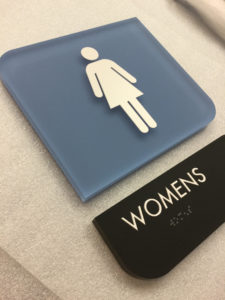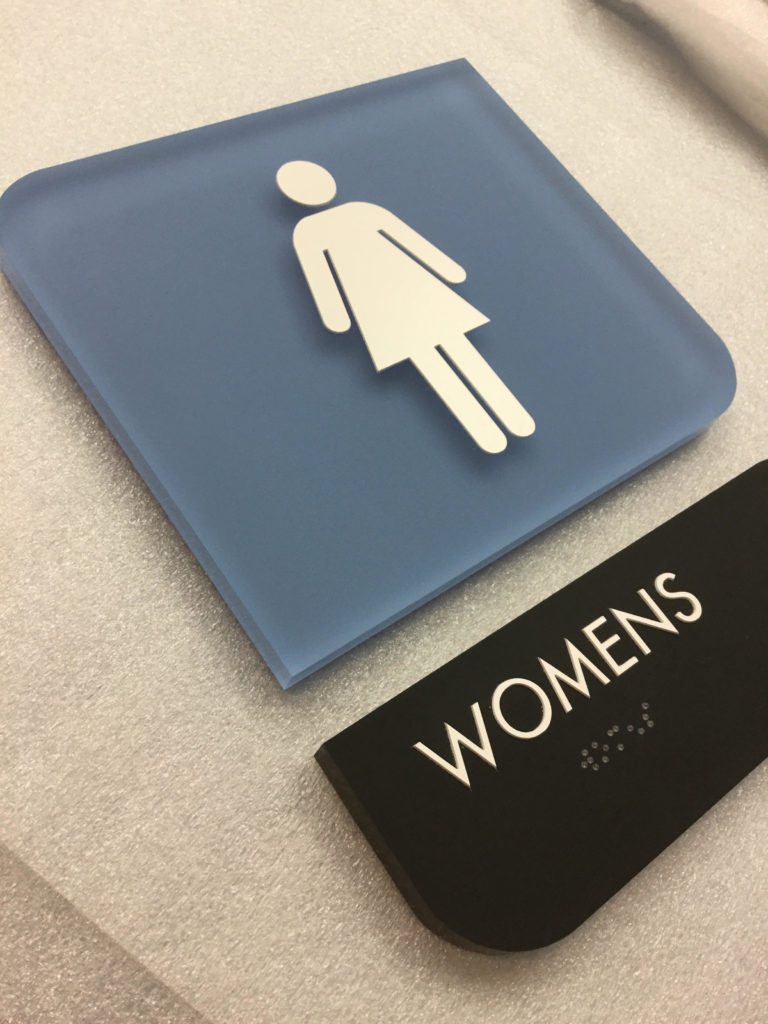What are ADA Signs?
ADA signs refers to signs that are designed, manufactured, and installed in accordance with the guidelines set forth by the Americans with Disabilities Act (ADA). These guidelines ensure that signs are accessible and usable by people with disabilities, including those who are blind, have limited vision, along with those who are deaf or hearing impaired, and those who have mobility impairments.
 One of the primary goals of ADA compliant signage is to provide information and direction to individuals with disabilities in a manner that is equal to the information and direction provided to individuals without disabilities. This includes providing braille and tactile letters for individuals who are blind or have low vision. Blind or visually impaired people should be able to run their fingers across the braille or raised text to read the message communicated on the sign.
One of the primary goals of ADA compliant signage is to provide information and direction to individuals with disabilities in a manner that is equal to the information and direction provided to individuals without disabilities. This includes providing braille and tactile letters for individuals who are blind or have low vision. Blind or visually impaired people should be able to run their fingers across the braille or raised text to read the message communicated on the sign.
ADA compliant signage is also designed to enhance the overall accessibility of a facility, be it a public building or private workplace. This may include providing braille and tactile directional signs to help individuals with visual impairments navigate a building, or using high contrast colors and large font sizes to make signs more visible to individuals with low vision.
ADA compliant signage is critical for ensuring that individuals with disabilities have equal access to information and facilities. By designing and installing signs that meet the guidelines set forth by the ADA, businesses and organizations can create inclusive and welcoming environments for all individuals.
What is the Americans with Disabilities Act (ADA)?
The Americans with Disabilities Act (ADA) is a civil rights law that was signed into law by President George H. W. Bush in 1990. The ADA prohibits discrimination and ensures equal opportunity for individuals with disabilities in employment, transportation, public accommodation, communications, and governmental activities.
The ADA was the culmination of decades of activism by individuals with disabilities and their allies. In the 1960s, the disability rights movement began to gain momentum, as people with disabilities began to demand equal rights and opportunities. This movement was inspired, in part, by the civil rights movement and the feminist movement, which had successfully fought for the rights of African Americans and women, respectively.
One of the key events that led to the ADA was the passage of the Rehabilitation Act of 1973. This act prohibited discrimination on the basis of disability in programs and activities receiving
federal financial assistance. However, the Rehabilitation Act did not cover private sector employment or public accommodations, such as restaurants and movie theaters.
In the 1980s, disability rights activists worked to get a more comprehensive law passed that would cover all areas of life. In 1988, Congress passed the Fair Housing Amendments Act, which extended the protections of the Rehabilitation Act to people with disabilities in the areas of housing and transportation.
Finally, in 1990, the ADA was signed into law. The ADA was a historic piece of legislation that recognized the rights of individuals with disabilities as equal to those of individuals without disabilities. The ADA has had a profound impact on the lives of people with disabilities, and has helped to create a more inclusive and accessible society for all.
The ADA has been amended several times since its original passage, most recently in 2008 with the ADA Amendments Act. This act broadened the definition of disability and made it easier for individuals with disabilities to demonstrate that they are covered under the ADA.
ADA Sign Requirements
There are several specific requirements that must be followed when installing ADA compliant signage. These requirements are designed to ensure that the signs are easily readable and understandable by individuals with disabilities.
First, the sign must be located at an appropriate height. For text-only signs, the centerline of the characters should be located between 48 inches and 60 inches above the finish floor or ground. For signs with visual graphics, the baseline of the lowest graphic should be located between 40 inches and 48 inches above the finish floor or ground.
ground. For signs with visual graphics, the baseline of the lowest graphic should be located between 40 inches and 48 inches above the finish floor or ground.
Second, the sign must have a non-glare finish to ensure that it is easy to read. This is particularly important for individuals with low vision, who may have difficulty reading signs with glare or reflections.
Third, the sign must have high contrast between the background and the text or graphics. This is important for individuals with low vision, as well as those who are colorblind. The ADA recommends a contrast ratio of at least 70% between the text and the background color.
Finally, the sign must use appropriate fonts and lettering size. The minimum recommended letter height for main text is 5/8 inch, and the minimum recommended letter height for secondary text is 3/8 inch.
By following these guidelines, businesses and organizations can create inclusive and accessible environments for all.
Elmark is one of the leading manufacturers of ADA compliant signage in America. Need help with ADA compliant signs for your business? Click HERE!



